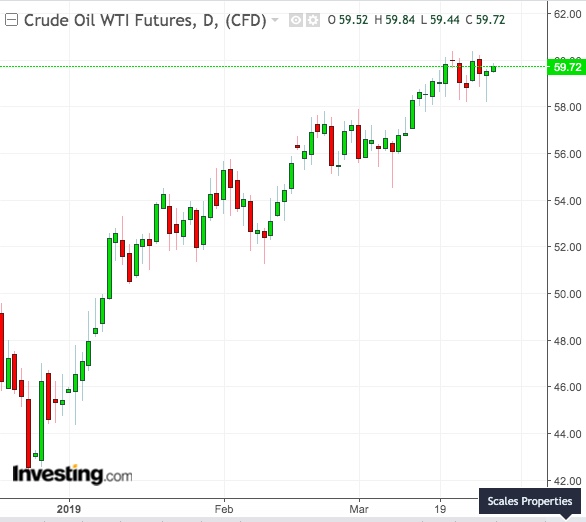America’s most prominent oil drillers have under-hedged their production for 2020 despite this year’s rally in crude, according to data from Goldman Sachs that’s almost certain to give joy to OPEC.

Wall Street’s closely-followed energy researcher said in a note that as 2020 producer hedging came into greater focus, it sensed considerable restraint among U.S. oil exploration and production companies (E&P) to rush out and commit to more barrels simply because crude prices were up 30% on the year.
U.S. Drillers Prioritizing Dividends, Cash Flows Over Hedging
Many of the so-called E&P companies appeared thankful that the crude price collapse of Q4 2018, though intense, was short and were resolved not to let another one recur soon.
As such, they were turning money saved from reduced drilling and other costs into dividends that would please shareholders. They were also bolstering their cash flow and moderating market participation to ensure they neither contributed nor became ensnared in the types of market crash that occurred between 2014 and 2017 that took out so many of their peers.
The Goldman Sachs note was first distributed to the company’s clients on Wednesday. It was shared with the broader market on Thursday, when traders’ attention was almost entirely on U.S. President Donald Trump’s tweet that oil prices were too high and that OPEC should raise production. Not surprisingly, the note was lost in market noise.
Yet, if one were to comb through its contents, some profound conclusions could be made.
In verbatim, here are four main things Goldman Sachs (NYSE:GS) said:
-
“We saw a slight uptick in 2019 hedged oil production with 31% of 2019 oil production (vs. 28% with our previous update) hedged at an average price of $57.50/bbl.”
-
“2019 hedged oil/liquids production is below historical averages post-4Q earnings update.”
-
“We also note that 2020 hedges remain modest—only 6% of expected production is hedged vs. 4% post 3Q18 results.”
-
“We note that the increased percent of production hedged in both 2019 and 2020 for oil could also be helped by a lower denominator, given that many companies revised production growth estimates lower with 4Q results.”
Shale Production Poised To Ebb Out?
If true, the findings by Goldman Sachs paint a remarkably different picture of the U.S. oil industry and psyche of the average shale driller, who’s often thought to live by the motto: “Drill, baby, drill!”
It explains why the U.S. oil rig count, an indicator of production, has fallen to 11-month lows this year and been declining since late February despite West Texas Intermediate crude set to finish March with its best quarter in a decade.
If the trend keeps up, the U.S. Energy Information Administration’s forecast for a record high production of above 13 million barrels per day in 2020 might even be challenged. Just two weeks back, the EIA lowered its expectation for 2019 production by almost 1.0 percent to 12.3 million bpd. The agency still maintains its grander forecast that by 2025, America will out-produce all of Saudi and Russian oil combined.
Despite that, any downward revision by the EIA is closely watched as some analysts believe that continuously high growth in production cannot be sustained over time in U.S. oil because many of the promising spots have been drilled out and decline rates at wells were getting faster.
Others counter that theory, arguing that shale is a relatively new game—barely prolific for a decade now—and point to similar contentions in the past about Russian oilfields that had been disproven. Also, Big Oil companies are getting excited about shale just as the smaller, independent drillers are turning conservative. Exxon Mobil (NYSE:XOM) and Chevron (NYSE:CVX), for instance, have their sights on extracting an additional million barrels each from the Permian, the most productive shale basin. Exxon also says it can see double-digit profits at $35 per barrel and is seeking even lower costs at $15—a sign it will continue ramping up production long after the next market crash.
GS Analysis Set To Strengthen OPEC's Call For Supply Cuts
But even so, all that is in the longer term. In the immediate outlook for the next quarter or two, assertions of a less-hedged U.S. shale industry, followed by prognosis of lower production in 2019/20, couldn’t be sweeter for OPEC.
Despite executing some of the most audacious production cuts in history and risking its market share, OPEC’s de facto leader Saudi Arabia has been frustrated by talk that shale oil will come back better and bigger to flood the market—a notion that has successfully prevented global benchmark Brent from hitting the $70 per barrel mark, let alone reach the $80-$85 sweet spot for Riyadh’s budget.
But with a top Wall Street bank laying out the case for restrained U.S. output, the Saudis can corroborate their narrative that the market will remained undersupplied this year and possibly through 2020, as production cuts by OPEC and Russia combine with U.S. sanctions on Venezuelan and Iranian oil.
